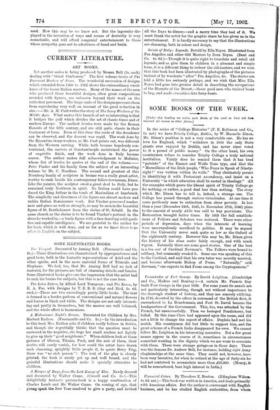CURRENT LITERAT URE.
ART BOOKS.
Yet another series is being produced by Messrs. Bell (5s. each) dealing with "Great Craftsmen." The first volume treats of The Pavement Masters of Siena. The wonderful succession of designs which extended from 1369 to 1562 shows the extraordinary excel- lence of the lesser Italian masters. Many of the names of the men who produced these beautiful designs, often great compositions crowded with figures, are unknown beyond their work on the cathedral pavement. The large scale of the designs prevents them from reproducing very well on account of the great reduction in size.—Mr. A. M. Cust writes the story of The Ivory Workers of the Middle Ages. What makes this branch of art so interesting is that it bridges the gulf which divides the art of classic times and of modern Europe. The earliest ivories were made for the Roman Consuls of the fifth century, and are still quite classic in their treatment of form. Even at this time the seeds of the decadence can be observed, and the descent was rapid. The work done by the Byzantine ivory-workers, as Mr. Cust points out, was different from the Western carving. While both became hopelessly con- ventional, the carvers at Constantinople maintained the power of exquisite finish, and the work done in Italy became coarse. The author makes full acknowledgment to Molinier, whose list of ivories he quotes at the end of the volume.— Peter Vischer and his family form the subject of an interesting volume by Mr. C. Headlam. The second and greatest of this Nurnberg family of sculptors in bronze was a really great artist, worthy to rank beside his contemporary fellow-townsman, Durer. Like the painter, the sculptor owed a great deal to Italy, but he remained truly Northern in spirit. No Italian could have pro- duced the King Arthur in the tomb of Maximilian at Innsbruck. The simplicity and directness of the figure are almost modern and Unlike Italian Renaissance work. But Vischer possessed tender- ness and grace as well as strength, as may be seen in the beautiful figure of St. Bartholomew from the shrine of St. Sebald. In the same church as the shrine is to be found Viseher's portrait in the dress he worked in,—a burly figure with a face denoting solid quali- ties and capable intelligence. We are grateful to the author for his book, which is well done, and as far as we know there is no other in English on the subject.






































 Previous page
Previous page